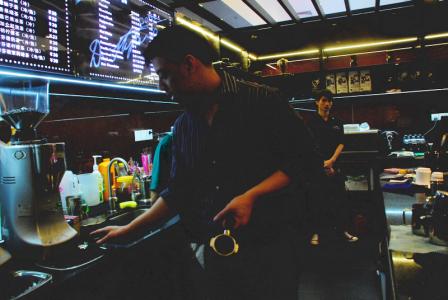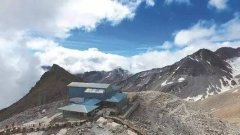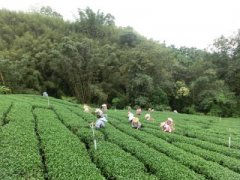Ethiopian Coffee Manor Fine Coffee Bean Origin, Development, History and Culture

In December 1994, the Constitution of the Federal Democratic Republic of Ethiopia was enacted. The constitution stipulates that Ethiopia will adopt a federal system and a parliamentary cabinet system after the election, with a term of office of five years. National elections were held in May 1995. On August 22, the Federal Democratic Republic of Ethiopia was established. Meles became Prime Minister as Chairman of the Majority Party in the House of People's Representatives. On May 14, 2000, Ethiopia held a national election, in which the Ethiopian Revolutionary Front defeated other opposition parties by an absolute majority to retain power. In October, a new federal parliament and government were established. The presidents of both houses and Prime Minister Meles were elected for re-election. The original cabinet was also retained with the approval of the parliament. In October 2001, Mei adjusted the government structure and reorganized the cabinet, adding the Ministry of Youth, Sports and Culture and the Ministry of Taxation, and established a new cabinet composed of 18 ministers. Ethiopia is dominated by mountainous plateaus, mostly subordinate to the Ethiopian plateau. The central and western parts are the main part of the plateau, accounting for 2/3 of the whole territory. The Great Rift Valley of East Africa runs through the whole territory, with an average altitude of nearly 3,000 meters. It is known as the "Roof of Africa". The terrain around the plateau gradually declines. The Darol depression in the north drops to 113 meters below sea level, the lowest point in the country. The Red Sea coast is a narrow strip of plain. The desert and semi-desert areas in the north, south and northeast account for about 25% of the country's area. Mount Dashan in the West Gate Mountains is 4,623 meters above sea level and is the highest peak in Ethiopia.
Ethiopian coffee grades:
Ethiopia washed coffee yejia sherfi G1 G2
The highest grades of Yirgacheffe, Sidamo are Grade II and Grade III (G2, G3),
Most of the sun-processed coffee in eastern Ethiopia is grade 4 or grade 5 (G4, G5).
In many cases, fourth-grade coffee is labeled as five-grade in order to reduce taxes. The current classification is not uniform and somewhat chaotic, because there are also Grand G2 and Grand G2 for sun-processed Yirga Cheffe coffee, but Harar is the highest grade (G4).
Ethiopia's coffee producing areas are Sidamo, Harrar and Yirgacheffe. Sidamo and Harrar are provinces and divisions. Sidamo is located in the south of Ethiopia adjacent to Kenya. Harrar borders Somalia in the east of Ethiopia. Although Yirgacheffe is a small area in Sidamo region, due to soil composition and water content, its coffee production is considered to be the best in Ethiopia.
In the West, Ethiopian coffee is marketed as Yirgacheffee, Sidamo and Harrar.
In the fine coffee sector, there are five other small local coffees, namely Limmu, Djimmah, Lekempti, Bebeka and Wolega. The most common coffee is either Sidamo or Harrar coffee.
Harar Coffee is produced in the eastern highlands of Ethiopia. It is medium bean-shaped, green-yellow, medium acidity, full bodied and has a typical mocha flavor. It is one of the most famous coffees in the world.
Wollega (Nekempte) coffee is produced in western Ethiopia. It is medium to large in bean shape and is famous for its rich fruit flavor. Green, brown color, acidity and body are good. It can be made into a combination or a single item.
Limu Coffee is known for its spicy and Winnie flavor and is popular in Europe and America. Acidity, good body, washed Lim coffee is also a fine coffee darling. Bean-shaped medium, green-blue, mostly round.
Sidama Coffee (Sidama Coffee) bean-shaped medium, green-gray, Sidamo washed coffee to taste, flavor balance for the characteristics, known as sweet coffee (sweet coffee), fine acidity, good body, produced in southern Ethiopia, can be combined with fine products.
Yirgacheffe Coffee has a strong floral flavor.
Washed coffee is one of the world's best high-quality coffee, soft acidity, rich body. Top and Bebeka coffees, low in acidity but high in body, are indispensable members of the blend coffee.
Coffee farming villages produce about 35 percent of the country's coffee. These coffee farms, which use a multi-tiered coffee growing system, are carefully cared for. Coffee farmers do not use chemical fertilizers, but use fallen leaves, plant and animal debris to increase soil nutrients. In addition to coffee, farmers also frequently grow non-coffee crops. Even manor coffee (coffee produced on state farms), which accounts for 5% of the country's coffee production, exhibits forest-type coffee production characteristics.
Located in the most privileged natural conditions, Ethiopia produces unique high-quality coffee every year. Ethiopia's coffee growing cycle brings harvest joy to the country every year. Beautiful white coffee flowers bloom and bear fruit every year between March and April. Only the reddest and most mature fruits are selected for coffee between September and about December. The export of new coffee begins in November or December each year when new coffee varieties are bred in Ethiopia's western highlands that resist fruit disease or leaf rust.
Ethiopia is known for its many coffee types. Some of the major coffee types are known for their unique aromas and flavors, including the following:
Limu Coffee
This coffee is grown at altitudes ranging from 1400 to 2000 meters. This coffee is wet processed and has a strong aroma; the fruit is full and the pH is moderate; the quality is excellent and the spicy flavor is attractive. It is estimated that the average annual production of this coffee is 29000 tons (equivalent to 480,000 bags of 60 kg coffee) out of 49000 hectares of cultivated area.
Djimma Coffee
- This coffee is grown at altitudes ranging from 1400 to 1800 meters. This coffee is natural or sun coffee; weak to medium acid, full fruit, good average quality; rich aroma; a drop in the mouth, aftertaste endless. It is estimated that the average annual production of this coffee is 70000 tons (equivalent to 1.17 million bags of 60 kg coffee) out of 127000 hectares of cultivated area.
Yirgachefe Coffee--
This coffee is grown at altitudes ranging from 1500 to 2200 meters. The coffee is washed in clear streams, hand-picked and fully sun-washed. The taste is unique; the fruit is medium-sized and comparable to mocha. Taste mellow, unique charm, give people a sense of refreshing, optimistic market prospects. It is estimated that the average annual production of this coffee is 28000 tons (equivalent to 470,000 bags of 60 kg coffee) out of 42000 hectares of cultivated area.
Important Notice :
前街咖啡 FrontStreet Coffee has moved to new addredd:
FrontStreet Coffee Address: 315,Donghua East Road,GuangZhou
Tel:020 38364473
- Prev

Unique Ethiopian Coffee Manor boutique Coffee Bean Flavor, taste and aroma description Jane
Grade of Ethiopian coffee: Ethiopian washed coffee Yega Chuefei G1 G2 Sidamo (Yirgacheffe, Sidamo) has the highest grades 2 and 3 (G2, G3), while sun-processed coffee in eastern Ethiopia is mostly grade 4 or 5 (G4, G5). In many cases, level 4 coffee is marked as level 5 in order to reduce taxes. At present, the classification is not uniform and there are
- Next

A brief introduction to the Market Price of Fine Coffee Bean varieties in the Sweet and lovely Ethiopian Coffee Manor
Yirgachefe Coffee this coffee grows in areas ranging from 1500 to 2200 meters above sea level. This coffee is washed in a clear stream, carefully selected by hand and exposed to plenty of sunshine. The taste is unique; the fruit is medium-sized, comparable to Mocha. The taste is mellow, the charm is unique, it gives people a fresh feeling, and the market prospect is optimistic. According to estimates, in 4200
Related
- Does Rose Summer choose Blue, Green or Red? Detailed explanation of Rose Summer Coffee plots and Classification in Panamanian Jade Manor
- What is the difference between the origin, producing area, processing plant, cooperative and manor of coffee beans?
- How fine does the espresso powder fit? how to grind the espresso?
- Sca coffee roasting degree color card coffee roasting degree 8 roasting color values what do you mean?
- The practice of lattes: how to make lattes at home
- Introduction to Indonesian Fine Coffee beans-- Java Coffee producing area of Indonesian Arabica Coffee
- How much will the flavor of light and medium roasted rose summer be expressed? What baking level is rose summer suitable for?
- Introduction to the characteristics of washing, sun-drying or wet-planing coffee commonly used in Mantenin, Indonesia
- Price characteristics of Arabica Coffee Bean Starbucks introduction to Manning Coffee Bean Taste producing area Variety Manor
- What is the authentic Yega flavor? What are the flavor characteristics of the really excellent Yejasuffi coffee beans?

